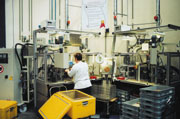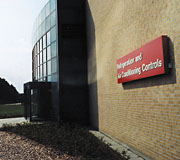A recent Danfoss media event here included visits to four of those facilities, and the company emphasized the latest in computerized technologies, new ways to involve employees, avoidance of too much inventory, and the quick movement of products from the assembly line to the customer.

Valves in Nordborg
Down the road from the corporate headquarters is the Refrigeration & Air Conditioning Controls plant. Several thousand stainless steel and T-2 valves come out of this plant every day.The plant has sloped ceilings with skylights; artificial lighting is automatically adjusted depending on the amount of outside light.
The stress on automation is reflected in a work force of just more than 100. The valves run along conveyor belts, most enclosed behind sound-reducing and eye-protective glass. Each automated component performs one small part of the assembly task. One mechanical arm, for example, twists a corner of a cap tube to an upright position. The next arm twists that corner into the center of the radius of the wound tubing. A laser machine labels each valve as to type, date, and the shift it was assembled on. Another machine positions each valve onto pallets that are automatically changed when full.
Each weekend, maintenance crews work through a checklist and perform service work on the automated lines.
Electrical panels are mounted overhead on catwalks, so each can be serviced, but they are out of the way of the workers.
Testing is critical as well. To make sure the automated test equipment doesn’t miss anything, dummy valves with built-in defects are run through the test equipment from time to time to ensure that defects are being spotted.
Improved productivity remains of utmost importance. State-of-the-art technology is regularly introduced. Since January, employees have been rotating among job assignments to see who works best in various areas. Production teams include engineers, foremen, and blue-collar workers.
An exercise facility is on site for the employees. Fruit is put out each morning for workers to take as they wish.
Next door to the corporate office is a plant that makes electro-mechanical and electronic thermostats. Those seemingly simple components undergo a similar automated assembly line approach. As the finished products roll off the line, the viewer can begin to appreciate the massiveness of the domestic refrigeration market. Each year, the plant produces 7 million of the 16 million such components that Danfoss manufactures in plants in Denmark, Italy, Slovenia, Mexico, and Brazil.
Solenoids From Kolding
Solenoid valves from the Danfoss factory in Kolding make their way through much of the world.Some 500 people, including 400 on the shop floor, work in the plant, which runs three shifts a day.
Plant manager Hans Eskildsen likes the size of the Kolding operation — large enough to be profitable but not overwhelming in size. When entering the shop area, he said he can get an overview of the operation at a glance and maintain a feel for what’s happening there.
Eighty-five percent of those working on the floor are women, which Eskildsen attributes to their ability to handle the sometimes dexterous assembly of components.
The assembled solenoids go into cold storage facilities, supermarket display cases, and heat pumps, among other applications.
Machinery is often enclosed in plexiglass to cut down on noise and eliminate the need for employees or visitors to wear safety glasses.
The factory has been around since 1978. Two recent trends involve a Danish variation of just-in-time production and a teamwork approach.
The production structure is designed to cut down on inventory. In fact, visitors to the Kolding plant in recent years have noticed the inventory area shrinking to be replaced by more and more sophisticated manufacturing equipment. Eskildsen can order exactly the quantity and type of raw materials needed and then organize the assembly to meet specific customer requests. Orders that come in that morning can yield finished goods later that day.
Floor personnel work in teams of 5 to 10 people, assembling a product from start to finish. “If people are involved, they will understand. Then they will be motivated,” said Uwe Bartram, manager of communication and sales promotion for the Danfoss refrigeration and a/c business segment.
At the Kolding plant, the research and development team works in conjunction with the sales and marketing department to make sure the products coming to market sell.
Employees work a 37-hour week. They get about six weeks of vacation a year. Like other plants, an exercise facility is on site.
Change is constant. “By the time we make a change, we may start going another way,” said Eskildsen. “Oftentimes development doesn’t come from planning. It comes from making change.”

Compressors in Flensburg
The Flensburg, Germany plant opened in 1956. At the time, various export issues regarding Denmark motivated the Denmark-based Danfoss to open the Flensburg plant just a few hundred feet across the border in Germany.Those issues have faded, but Flensburg remains a production powerhouse, turning out small compressors for use in domestic refrigerators and water coolers and other applications.
The Flensburg plant and its more recently opened sister plants in Slovenia and Mexico have been responsible for some 200 million compressors in 40-plus years. (The Mexico plant, opened in 1996, is part of Danfoss’ efforts to increase its penetration of the U.S. domestic market.)
Assembly line jobs are rotated and automation is present everywhere. The compressors are welded automatically in a process that takes only a few seconds and yields near flawless welds. Three enclosed welding boxes allow three compressors to be done at one time.
A new aspect of the plant is a research area in which chambers stacked three high with 16 stacks to a row can test 248 compressors at one time. Everything is linked by computer, so results can be monitored from offices. The goal is to produce compressors that will last 15 years.
Publication date: 06/18/2001


Report Abusive Comment